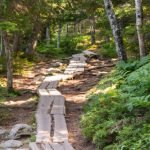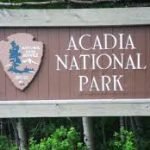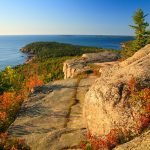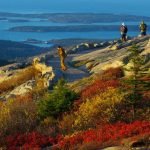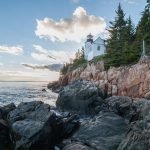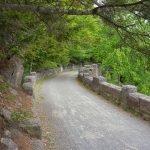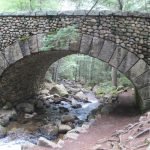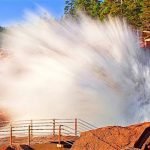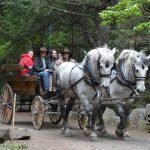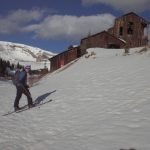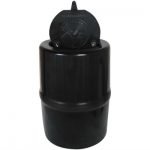At 1,530 feet in both elevation as well as being somewhat well known, Cadillac Mountain has the distinction of being the highest point of not only Acadia National Park but of the entire North Atlantic coastline. Due to its height and northeastern longitude, the mountain is the very first place in the continental United States to be illuminated by the rising sun each morning. The first national park east of the Mississippi River, Acadia National Park offers hiking, biking, camping, great views of rugged coastlines, and clear lakes. This National Park is made up of several islands along the Maine coast and a section of the mainland on the Schoodic Peninsula. Acadia National Park protects more than 47,000 acres, 35,332 acres owned by the National Park Service and (somewhat uniquely) 12,416 acres of privately owned lands that are under conservation easements managed by the National Park Service.
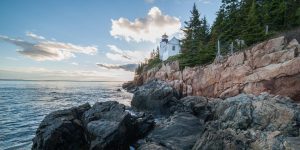
In the fall of 1604, explorer Samuel de Champlain and his ship arrived from Europe to land on the ground that would, in time become Acadia National Park. In 1901 George B. Dorr established the Hancock County Trustees of Public Reservations. The corporation, whose sole purpose was to preserve land for the perpetual use of the public, acquired 6,000 acres by 1913. Dorr offered the land to the federal government, and in 1916 President Wilson announced the creation of Sieur de Monts National Monument. Dorr continued to acquire property and renewed his efforts to obtain full national park status for the area. In 1919, President Wilson signed the act establishing Lafayette National Park. Less than three years later, on February 26, 1919, the area was re-designated and renamed as Lafayette National Park. Then, on January 19, 1929, the park was again renamed Acadia National Park – and like its appeal, the name
has lasted until now.
While the U.S. government focused on the establishment and protection of the park – John D. Rockefeller, Jr., a wealthy Mount Desert Island landowner, had plans of his own. From 1915 to 1933, Rockefeller dedicated his efforts and resources to the development of his vast island estate and the establishment of the carriage paths. Originally intended as a diversion for guests and dignitaries, Rockefeller developed more than 50 miles of trails to provide carriage and horseback access to the island’s remote beauty. He spared no expense and constructed 17 arched granite bridges to achieve his vision. John D. Rockefeller, Jr. donated over 11,000 acres of his land to the National Park. The carriage paths were rehabilitated between 1992 and 1995 to restore them to their original usefulness and beauty. There are 45 miles of Carriage Roads for the use of hikers, bikers, horse riders, and horse-drawn carriages on the (Mount Desert) island. This diverse network of woodland “broken-stone” roads is free of motor vehicles. Cars are not permitted on these Carriage Roads.
—- Location —-
Acadia National Park is on Mount Desert Island, along the Maine coast about halfway between New Hampshire and New Brunswick, Canada. The 80,000-acre island—18 miles long, 14 miles wide, and roughly shaped like a lobster claw—is connected to the mainland by a short bridge and causeways. To get here by car from Boston take I-95 north to Augusta, Maine, then take Maine Route 3 east to Ellsworth and continue on to Mount Desert Island.
—- Park Camping —-
There are 4 main campgrounds within the National Park, with 572 campsites. Most of these are primitive sites with the exception of the Seawall Campground (47 sites) which has electric and water hookups available. The National Park website advises that “Park campgrounds are very popular. Finding a campsite upon arrival is a rare occurrence during good weather. Please make your reservation in advance.” Water and toilets are available within the Park, but showers are not. There are other campgrounds outside the Park a short distance away that have more amenities. Campgrounds are open year-round within the Park, but water (toilets, faucets) is generally only available from late May to late September. Blackwoods & Seawall Campgrounds are a 10-minute walk to the Atlantic.
—- Free Camping —-
Based on https://freecampsites.net/#!acaidia+national+park there are 10 free campsites within 50 miles of Acadia National Park.
—- Area Camping —-
http://www.rvparkreviews.com/maine/acadia-national-park?
https://www.hipcamp.com/discover/maine/acadia
https://www.goodsam.com/campgrounds-rv-parks/Acadia+Natl+Park
https://www.campendium.com/acadia-national-park
https://www.allstays.com/Campgrounds/me-bar-harbor-campgrounds.htm
https://koa.com/campgrounds/bar-harbor-oceanside/
—- Hiking & Biking & Horseback Riding —-
Hiking trails in Acadia National Park are often interconnected and range in difficulty from easy to hard. There are over 120 miles of trails to choose from. There are also about 45 miles of mountain biking trails to ride. The Eagle Lake Loop is a popular easy ride of just over 6 miles suitable for adults and children. You can ride in a horse-drawn carriage or bring your own horses if you have them to ride on the 45 miles of Carriage Roads.
https://www.outdoorproject.com/blog-news/10-acadia-national-parks-best-day-hikes
https://www.alltrails.com/parks/us/maine/acadia-national-park
https://www.mtbproject.com/directory/8008454/acadia-national-park
https://www.trails.com/maine/mountain-biking
https://www.nps.gov/acad/planyourvisit/horsebackriding.htm
http://www.acadia.ws/wildwood-stables.htm
—- Things To Do —-
Bar Harbor, Maine has lots of fun things to see and do if you want to wander a short distance from the Park. If this is your first time to the park, drive the Park Loop Road. This loop is definitely cool. The Park Loop Road is a 27-mile road that loops around the eastern part of Mount Desert Island. Most of it is one-way only. Make sure to explore the Carriage Roads with hiking, biking or being on or pulled by a horse in a carriage.
https://visitmaine.com/things-to-do/lighthouses-and-sightseeing/places-to-visit-acadiahttps://www.musingsofarover.com/things-to-do-in-acadia-national-park/
https://www.visitbarharbor.com/see-do
http://www.acadia.ws/index.htm
https://www.fodors.com/usa/maine/acadiamount-desert-island//acadia-national-park
—- References —-
https://en.wikipedia.org/wiki/Acadia_National_Park
https://commons.wikimedia.org/wiki/Category:Acadia_National_Park
https://www.nps.gov/acad/index.htm
https://www.nationalparks.org/explore-parks/acadia-national-park
http://www.acadia.ws/
- B7386G Otter Cliff seen from Gorham Mountain Trail, Acadia National Park, Maine, USA
